Translate this page into:
Phytomediated synthesis of bimetallic Ag/Au nanoparticles using orange peel extract and assessment of their antibacterial and anitcancer potential
⁎Corresponding authors. mawad@ksu.edu.sa (Manal.A. Awad), mmalenazy@pnu.edu.sa (Meznah M. Alanazi),
-
Received: ,
Accepted: ,
This article was originally published by Elsevier and was migrated to Scientific Scholar after the change of Publisher.
Peer review under responsibility of King Saud University.
Abstract
The current research interest in nanoscience centers around the synthesis of nanoparticle with noble metals due to their distinctive characteristics that has expanded their prospective utilization in various fields of science and technology. The study reports the green fabrication of bimetallic composite nanoparticles (CNPs) with silver (Ag) and gold(Au) via an eco-friendly mode with a biomaterial, orange peel (OP) extract as a reductant. The reaction of aqueous solutions of silver nitrate (AgNO3) and chloroauric acid (HAuCl4) with the OP extract resulted in rapid production of stable CNPs having spectacular spherical shapes and other morphologies. The characterization of the synthesized CNPs included the following analyses; UV–vis spectrophotometer, (DLS) dynamic light scattering technique for the particles average size was found to be 138 nm with a polydispersity index (PDI) of 0.249. To identify the functional groups in biomolecules that emphasizes the reducing and capping agent for NPs, the Fourier transform infrared spectroscopy (FTIR) has been used. The characterization of as prepared NPs has been complemented with (TEM) transmission Electron Microscopy, and (SEM) scanning Electron Microscopy along with the (EDS) energy dispersive spectrometry for the elemental screening of the sample. Furthermore, antibacterial effect and the cytotoxicity activity against the human MDA cell line of the bimetallic CNPs were investigated. The key findings showed that the CNPs suspension possesses potent cytotoxic activity (and was highly effective against bacterial strains. Thus, the finding support the prospective therapeutic potential of the nanoparticles in nano medicine.
Keywords
Bimetallic nanoparticles
Green Synthesis
Orange peel extract
Cytotoxic activity and Antibacterial activity
1 Introduction
The prime goal of materials science is the synthesis of engineered nanostructures with novel properties. This has stimulated research interests in the field of nanotechnology to develop reliable methods to synthesize and stabilize metallic nanoparticles (E. Rasha et al., 2021). Application of noble metal nanoparticles; silver and gold or a combination of the two in the field of biomedicine is widely established with their bimetallic counterparts considered more promising in the field of chemical, physical, and biological sciences (Zubair et al., 2022). Ag NPs have been developed for their extensive use as bactericidal agents, catalysts in chemical processes, biosensors, and in electronics(Panhwar et al., 2022).In addition, the use of gold nanoparticles in biomedical imaging and diagnostic tests, in cancer treatment is also documented(Zhang et al., 2022). Furthermore, silver and gold nanoparticles have widespread applications in several biological applications owing to their enhanced optical properties such as absorption and strong surface electric field enhancement of the metal nanoparticles (Nejati et al., 2022).It has been observed that the remarkable properties of nanoparticles can be enhanced by combining two or more types of materials into a hybrid nanocomposite (Liu et al., 2022). Hybrid composite nanoparticles can be defined as well-organized nanomaterial consisting of two or more types of individual nanocomponents (Veluri et al., 2022). The combination of the two metals results in CNPs with a morphology and size that is different from the NPs when these constituent metals are used independently. Thus, broadening the possible range of applications. The tunable nature of alloy-AgAu composite nanoparticles as an interesting nanosystem has potential scope in industry and medicine (Shore et al., 2011).
Numerous chemical and physical methodologies have been formulated in the last two decades, to synthesize noble metal nanoparticles with different compositions and size. Certain inherent limitations of these methods include; potentially hazardous nature of precursors used (Ndolomingo et al., 2020; Kaabipour and Hemmati, 2021; Rane et al., 2018). Biogenic synthesis is a promising replacement in which reactants used are primarily derived from natural sources; single celled organisms to higher plants. Several studies have reported a successful synthesis nanoparticles using Au and Ag and to also Pd and Pt using natural extracts which includes bacteria (Hendi et al., 2022; Lee et al., 2020; Hendi, 2011) and fungi (Ummartyotin et al., 2012) and plant parts (Zhang et al., 2020). The key benefits of a phyto mediated synthesis is the accessibility of phytoextracts and the idea of fostering ‘green’ technology with a minimal use of energy (Sharaf et al., 2022; Carbone et al., 2019).
The current study, reports an environmentally benign mode of synthesis of nanoparticles on the cornerstone of ‘green’ technology via the reduction of aqueous Ag+ and AuCl4– ions using aqueous boiled extract of orange peel. The therapeutic properties of the orange peel are well documented, being a potent anti-oxidant and is used in cancer therapy. It has extensive use in the field of medicine, cosmetics, industrial appliances and development of sustainable energy (Shehata et al., 2021; Chen et al., 2020).Thus, the biocompatibility of the synthesized Ag/Au bimetallic NPs warrants their potential use in biomedicine.
2 Experimental section
2.1 Synthesis of bimetallic Ag/Au nanoparticles
All chemicals used were of analytical grade. Silver nitrate (AgNO3) was purchased from Techno Pharmchem, India, chloroauric acid (HAuCl4) from Loba Chemie, India. For all the aqueous solutions Millipore water was used.
Fragments of the orange peels were added to 20 mL of deionized water and boiled for 3 min, thereafter the mixture was filtered.
Noble metal CNPs were synthesized by the biological reduction of Ag + and AuCl−4 ions when 5 mL of the aqueous solution of orange peel extract was added to 50 mL of the aqueous solution of 0.1 m mole/ml AgNO3 and 50 mL 0.1 m mole/ ml HAuCl4 solution separately at room temperature. Thereafter, all the solutions were mixed together and then the final solution was placed on the shaker at 125 rpm in dark at 39 Co. The reaction mixture was mechanically shaken until the CNPs were formed.
2.2 Characterization
The characterization included; UV–visible spectroscopy using a Perkin Elmer UV–visible spectrometer. Thermo Scientific, Nicolet 6700, FT-IR Spectrophotometer recorded the infrared (IR) spectrum. The size of the synthesized Ag/Au hybrid nanoparticles was analyzed with a Zeta-Sizer, Nano series, HT Laser, ZEN3600 from Molvern Instrument, UK. Transmission electron microscopy (TEM) (JEM-1011, JEOL, Japan). The TEM was operated and measurements were made at an acceleration voltage of 100 KV. Scanning electron microscopy (SEM), JEOL-FE SEM; and an energy dispersive spectrometer (EDS) analysis was performed to confirm elemental silver and gold. Elemental analysis was performed using Oxford Instrument, Incax-act equipped with scanning electron microscopy.
2.3 Microorganisms and antibacterial activity method
Cultures of Escherichia coli and Staphylococcus aureus were used for the disc diffusion method was used to assess the antibacterial activities of biosynthetic CNPs (Halder et al., 2022). The zone of clearing was used as an assessment of the inhibitory activity. The experiments were performed in triplicates and mean values of the zone diameter were calculated.
2.4 Cell culture and cytotoxicity assay
Cell viability of human breast adenocarcinoma (MDA-MB-231) cells was evaluated at varying concentration of the CNPs via the MTT assay (Alwhibi et al., 2022).
3 Results and discussions
UV Vis spectroscopy demonstrated the ions of the constituent metals in solution. Instead of two separate peaks for silver and gold, the presence of Ag/Au CNPs was confirmed by a single SPR peak at 543(Fig. 1).The surface plasma resonance band at 543 nm reflects n* transitions (Aziz et al., 2019; Zhou et al., 2019). The plausible explanation to this is that Ag (I) and Au(III) ions were concurrently reduced by the biocomponents of the orange extract. This was further which proven by the gradual appearance of a violet color. The metals exhibit a distinctive SPR at a characteristic wavelength attributed to the appearance of the resonating effect due to the interaction between the metals electrons and the incident photons. Thus, the SPR peaks illustrate the light-interaction properties of CNPs (Krishnan Sundarrajan and Pottail, 2021).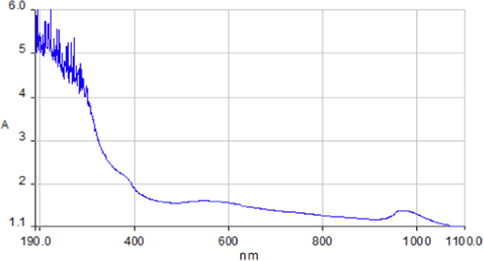
UV–vis spectrum of biogenic bimetallic CNPs.
The average hydrodynamic diameter of the synthesized CNPs was found to be 138 nm with a polydispersity index (PDI) of 0.249. The PDI result proved that the as prepared CNPs showed a monodispersed particle size distribution (Fig. 2). The size discrepancy between TEM and DLS could be due to the capping of the biomolecules on the surface of CNPs (Li et al., 2018).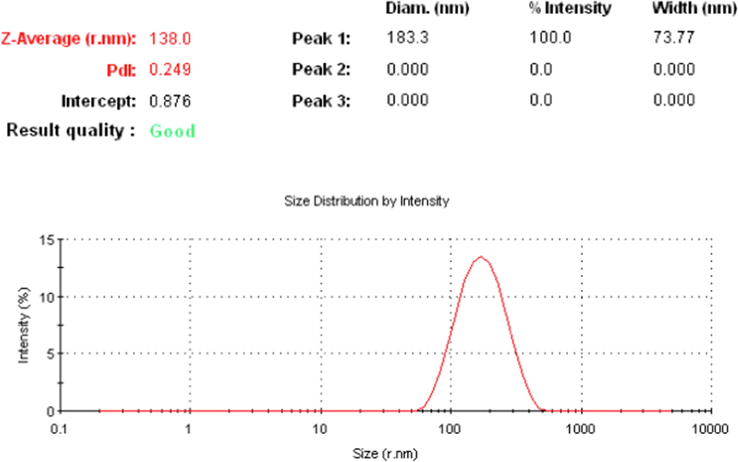
DLS analysis of biogenic bimetallic CNPs.
FT-IR spectrum illustrated the constituent biomolecules in the peel that contribute towards the stability of the hybrid Ag/Au nanoparticles. The FT-IR spectrum of the hybrid nanoparticles shows a band at 1633.27 cm-1 (Fig. 3), which corresponds to the C⚌C stretching of the aromatic ring. These results are consistent with that of the TLC test which showed flavonoids as the active constituent peel that was responsible for the bioreduction of aqueous silver (Ag + ) and gold (AuCl-4) ions. Orange peel extract FT-IR bands were derived at 3270.82 cm -1, 1634.24 cm−1 (Fig. 3), whereas the FT-IR spectrum of the hybrid bimetallic nanoparticles demonstrated peaks at 3260.70 cm−1, 1634.62 cm−1, 1376.62 cm-1and 1243.76 cm−1.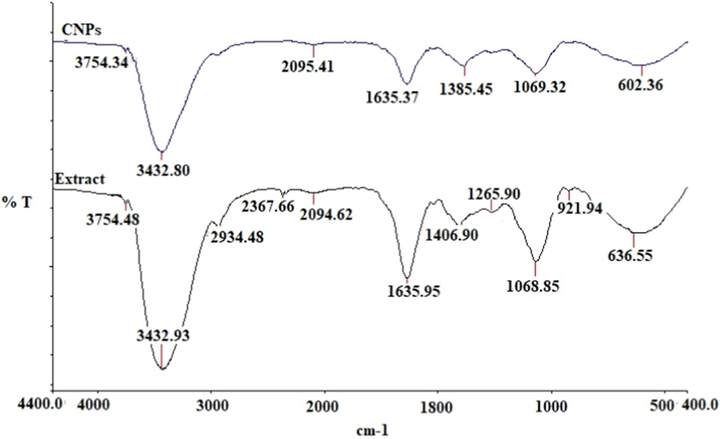
FTIR adsorption spectra of biogenic bimetallic CNPs.
According to the TEM images shown in Fig. 4, the phytochemically stabilized CNPs are monodispersed and almost spherical, with a nearly uniformly distribution. Several parameters; differences in electronegativity and valence electrons, lattice mismatch, and surface tension are accountable for the properties of the CNPs (Mavrikakis et al., 1998). However, a relatively wide mismatch in the lattice and the difference in surface energy between Ag and Au, it quite a challenge to develop homogeneity on the surface of the nanocrystal in a restrained manner (Ruban et al., 1997; Malik et al., 2021).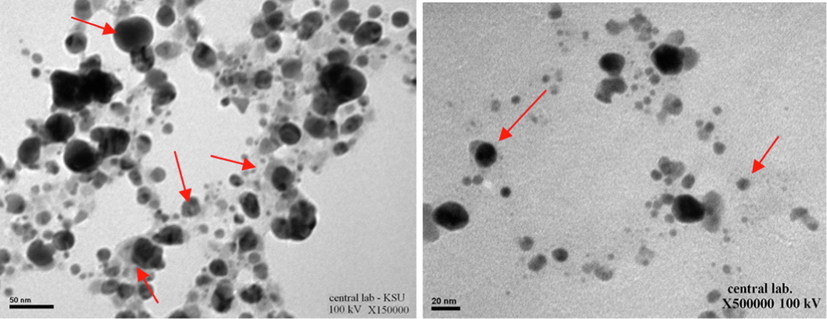
TEM images shows and illustrative the morphologies of biogenic CNPs.
Scanning electron microscope (SEM) image of CNPs from OP extract is shown in Fig. 5B. The presence of extremely small crystals, uniform and roughly spherical indicating a large percentage of monodispersity confirmed the bio reduction of the colloidal Ag/Au NPs. The EDS pattern in Fig. 5 showed the imprints for gold and silver atoms, visualizing the noble metals used. In addition, some distinctive signals for O, Mg, Na, K, Si, Cu, and Al elements were observed corresponding to their presence in the phytocompounds of the OP extract that work as capping agents (Sharma et al., 2020). The grid substrate used is responsible for a strong signal for the element O.
(left side) EDS pattern and (right side) SEM image of green bimetallic NPs.
The bactericidal activity of the orange peel extract with CNPs and the peel extract alone was assessed against Gram + ve and –Ve strains. The sample doses used were 10 and 5 mL/g via the diffusion well method. The antimicrobic effect of CNPs is shown in Table 1 and in Fig. 6 which was dose dependent and was significantly more pronounced than the orange peel extract itself. A wide zone of inhibition was observed for the Gram-ve strain, E. coli with CNPs in the preliminary qualitative antibacterial assay. However, the synthesized CNPs were not efficacious on S. aureus, Gram + ve strain of bacteria. Furthermore, the crude peel extract alone showed a lower inhibitory effect on both Gram + ve and Gram-ve bacterial strains. At the lower dose of 5 mL/g, the CNPs illustrated a maximum inhibition efficacy of 30 ± 0.02 mm while the higher dose of 10 mL/g showed 35 ± 0.00 mm due to the combined mutual effectiveness of metal ions for E.coli.This supports previous reports on understanding mechanistic approach which is contributed by the coactivity of Ag/Au metals coupled with the stabilization of the nanosystem brought about by the phytoconstituents in the peel extract which are the capping agents (Gopinath et al., 2016). In general, positively charged Ag/Au CNPs containing biomolecules are easily adsorbed to the thinner E. coli gram-negative peptidoglycan membrane, leading to cell lysis. These results are consistent with a previous study (Elemike et al., 2019; Franco et al., 2022; Shabana et al., 2022). Citrus peels have been used as a natural remedy. The main constituent, polymethoxyflavonoids (PMFs) endows it with anti-inflammatory activity (Alameen et al., 2022; Yoshizaki et al., 2014).
Treatment
E.coli
S.aureus
5 mL/µg of CNPs
30 ± 0.02
19 ± 0.01
10 mL/ µg of CNPs
35 ± 0.00
23 ± 0.00
Orange peel Extract
15 ± 0.00
8 ± 0.01
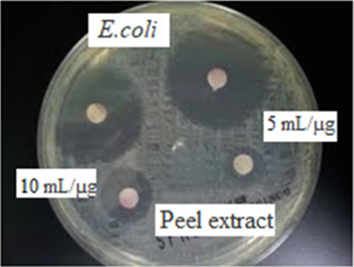
Antibacterial activity of synthesized CNPs against bacteria evaluated by diameter of the zone of inhibition(mm).
The in vitro cytotoxicity of synthesized CNP was evaluated using the MTT assay against human breast cancer cell lines (MDA-MB-231). A concentration-dependent reduction (Banday and Abdalla, 2022) in the percentage of viable cancer cells by the nanoparticles was observed as illustrated in Fig. 7. Within the concentration range of 20–50 l/mg CNPs the percentage cell viability was reduced to 50 %. This was an optimal concentration range of CNPs since a higher concentration between 60 and 80 l/mg showed a peak after which a further decrease in percent cell viability was observed at a concentration of 90 l/mg (Fig. 7). The profound biocidal and cytotoxic activity of the CNPs could be attributed to the significant biological activities of orange peel, being antimicrobic, antioxidative and anti-carcinogenic (Okoli et al., 2022). Recent studies have shown that citrus peel extract has a potent antioxidant status as compared to synthetic antioxidants (Contini et al., 2014). The presence of a multitude of phytoconstituents in citrus fruits; phenols, limonoids, flavonoids and polysaccharides that scavenge free radicals (Shehata et al., 2021) attribute to its strong antioxidant status. In addition, citrus peels have been reported to be endowed with profound antimicrobic activity across various foodborne pathogens (Lawal et al., 2013).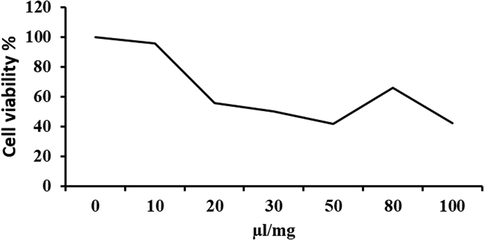
Effect of green synthesized AgNPs on MDA cell viability.
4 Conclusion
The current study reports green fabrication of bimetallic Ag/ Au hybrid nanoparticles using orange peel extract, via an environmentally benign, facile and cost effective method. Furthermore, the nanoparticle suspension showed a marked biocidal activity against Gram -ve bacterial strain, E.coli and cytotoxic activity against MDA cell lines. The mode offers a greener technological approach which could guarantee an extensive applications of the NPs in pharmaceutical, biomedical, diagnostic and therapeutic fields including nano medicine.
Acknowledgements
This work was funded by the Deanship of Scientific Research at Princess Nourah bint Abdulrahman University, through the Research Groups Program Grant no. (RGP-1443-0047).
Disclosure statement
There were no conflicts of interest reported by the authors.
Declaration of Competing Interest
The authors declare that they have no known competing financial interests or personal relationships that could have appeared to influence the work reported in this paper.
References
- In-silico studies of glutathione peroxidase4 activators as candidate for multiple sclerosis management. J. Saudi Chem. Soc.. 2022;26(6):101554.
- [Google Scholar]
- Green synthesis, characterization and biomedical potential of Ag@Au core–shell noble metal nanoparticles. J. King Saud Univ. Sci.. 2022;34(4)
- [Google Scholar]
- Structural and Optical Characteristics of PVA:C-Dot Composites: Tuning the Absorption of Ultra Violet (UV) Region. Nanomaterials. 2019;9(2):216.
- [Google Scholar]
- Immune Checkpoint Inhibitors: Recent clinical advances and future prospects. CMC. 2022;29
- [Google Scholar]
- A completely green approach to the synthesis of dendritic silver nanostructures starting from white grape pomace as a potential nanofactory. Arab. J. Chem.. 2019;12(5):597-609.
- [Google Scholar]
- In situ tuning proangiogenic factor-mediated immunotolerance synergizes the tumoricidal immunity via a hypoxia-triggerable liposomal bio-nanoreactor. Theranostics. 2020;10(26):11998-12010.
- [Google Scholar]
- Effect of an active packaging with citrus extract on lipid oxidation and sensory quality of cooked turkey meat. Meat science. 2014;96(3):1171-1176.
- [Google Scholar]
- Green synthesis of Ag, Au and Ag-Au bimetallic nanoparticles using Stigmaphyllon ovatum leaf extract and their in vitro anticancer potential. Mater. Lett.. 2019;243:148-152.
- [Google Scholar]
- Metal-based nanoparticles: Antibacterial mechanisms and biomedical application. Microorganisms. 2022;10(9):1778.
- [Google Scholar]
- Green synthesis of silver, gold and silver/gold bimetallic nanoparticles using the Gloriosa superba leaf extract and their antibacterial and antibiofilm activities. Microb. Pathog.. 2016;101:1-11.
- [Google Scholar]
- Green Synthesis of Bimetallic Au/Ag Nanostructures Using Aqueous Extract of Eichhornia crassipes for Antibacterial Activity. BioNanoScience.. 2022;12(2):322-331.
- [Google Scholar]
- Silver nanoparticles mediate differential responses in some of liver and kidney functions during skin wound healing. Journal of King Saud University-Science. 2011;23(1):47-52.
- [Google Scholar]
- In Silico Studies on Zinc Oxide Based Nanostructured Oil Carriers with Seed Extracts of Nigella sativa and Pimpinella anisum as Potential Inhibitors of 3CL Protease of SARS-CoV-2. Molecules. 2022;27(13):4301.
- [Google Scholar]
- A review on the green and sustainable synthesis of silver nanoparticles and one-dimensional silver nanostructures. Beilstein J. Nanotechnol.. 2021;12(1):102-136.
- [Google Scholar]
- Green synthesis of bimetallic Ag@ Au nanoparticles with aqueous fruit latex extract of Artocarpus heterophyllus and their synergistic medicinal efficacies. Appl. Nanosci.. 2021;11(3):971-981.
- [Google Scholar]
- Phytochemical screening and in vitro anti-bacterial studies of the ethanolic extract of Citrus senensis (Linn.) peel against some clinical bacterial isolates. Int. J. Innovat. Appl. Stud.. 2013;2:138-145.
- [Google Scholar]
- Recent developments in the facile bio-synthesis of gold nanoparticles (AuNPs) and their biomedical applications. Int J Nanomed.. 2020;15:275.
- [Google Scholar]
- Biosynthesis of Au, Ag and Au–Ag bimetallic nanoparticles using protein extracts of Deinococcus radiodurans and evaluation of their cytotoxicity. Int J Nanomedicine. 2018;13:1411.
- [Google Scholar]
- Heterostructures Made of Upconversion Nanoparticles and Metal-Organic Frameworks for Biomedical Applications. Adv. Sci. Lett.. 2022;9(3):2103911.
- [Google Scholar]
- Facile one-pot green synthesis of Ag–Fe bimetallic nanoparticles and their catalytic capability for 4-nitrophenol reduction. J. Mater. Res. Technol.. 2021;12:455-470.
- [Google Scholar]
- Effect of strain on the reactivity of metal surfaces. Phys. Rev. Lett.. 1998;81(13):2819.
- [Google Scholar]
- Review of supported metal nanoparticles: synthesis methodologies, advantages and application as catalysts. J. Mater. Sci.. 2020;55(15):6195-6241.
- [Google Scholar]
- Biomedical applications of functionalized gold nanoparticles: a review. J. Clust. Sci.. 2022;33(1):1-16.
- [Google Scholar]
- In Silico Study and Excito-Repellent Activity of Vitex negundo L. Essential Oil against Anopheles gambiae. Applied Sciences. 2022;12(15):7500.
- [Google Scholar]
- Synthesis and Characterization Approaches of Silver Nano particles for Various Novel Applications. Adv. Mater. Process. Technol. 2022:1-16.
- [Google Scholar]
- Methods for synthesis of nanoparticles and fabrication of nanocomposites. In: Synthesis of Inorganic Nanomaterials. Woodhead publishing; 2018. p. :121-139.
- [Google Scholar]
- Effects of zinc oxide nanoparticles synthesized using Aspergillus niger on Carbapenem-Resistant Klebsiella pneumonia in vitro and in vivo. Front Cell Infect Microbiol. 2021:1077.
- [Google Scholar]
- Surface electronic structure and reactivity of transition and noble metals. J. Mol. Catal.. 1997;115(3):421-429.
- [Google Scholar]
- Multifunctional nanoparticles based on marine polysaccharides for apremilast delivery to inflammatory macrophages: Preparation, targeting ability, and uptake mechanism. Int. J. Biol. Macromol. 2022
- [Google Scholar]
- Rhamnolipid-Coated Iron Oxide Nanoparticles as a Novel Multitarget Candidate against Major Foodborne E. coli Serotypes and Methicillin-Resistant S. aureus. Microbiol. Spectr.. 2022;10(4):e00250-e00322.
- [Google Scholar]
- Single-step green route synthesis of Au/Ag bimetallic nanoparticles using clove buds extract: Enhancement in antioxidant bio-efficacy and catalytic activity. Mater. Sci. Eng. C.. 2020;116:111153
- [Google Scholar]
- Antioxidant and antimicrobial activities and UPLC-ESI-MS/MS polyphenolic profile of sweet orange peel extracts. CRFS. 2021;4:326-335.
- [Google Scholar]
- Synthesis of Au (core)/Ag (shell) nanoparticles and their conversion to AuAg alloy nanoparticles. Small. 2011;7(2):230-234.
- [Google Scholar]
- Synthesis of colloidal silver nanoparticles for printed electronics. Comptes Rendus Chim.. 2012;15:539-544.
- [Google Scholar]
- Morphological Characterization of Bio-nanocomposites. In: Polymer Based Bio-nanocomposites. Singapore: Springer; 2022. p. :1-29.
- [Google Scholar]
- Orange peel extract, containing high levels of polymethoxyflavonoid, suppressed UVB-induced COX-2 expression and PGE 2 production in HaCaT cells through PPAR-γ activation. Exp. Dermatol.. 2014;23:18-22.
- [Google Scholar]
- Bioinspired nano-painting on orthopedic implants orchestrates periprosthetic anti-infection and osseointegration in a rat model of arthroplasty. J. Chem. Eng.. 2022;435:134848
- [Google Scholar]
- Green synthesis of metallic nanoparticles and their potential applications to treat cancer. Front. Chem.. 2020;8:799.
- [Google Scholar]
- Gold nanoclusters: Bridging gold complexes and plasmonic nanoparticles in photophysical properties. Nanomaterials. 2019;9(7):933.
- [Google Scholar]
- Green synthesis and characterization of silver nanoparticles from Acacia nilotica and their anticancer, antidiabetic and antioxidant efficacy. Environ. Pollut.. 2022;304:119249
- [Google Scholar]







